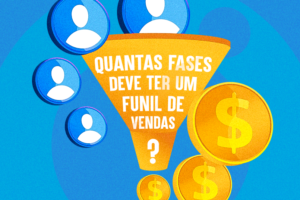
Lead no Marketing Digital
O que é Lead?
De forma bem simples e direta: Lead, no Marketing Digital, nada mais é do que um potencial cliente ou consumidor da marca da sua empresa.
Visitante, Lead e Vendas.
Visitante: usuário que já conhece a marca ou fez pesquisa prévia em buscadores como o Google, por exemplo, para chegar ao site. Visitou o site, conheceu, consumiu conteúdo, assistiu a vídeos mas não realizou nenhuma ação.
Lead: passou por todas as etapas que o Visitante executou e ligou ou preencheu um formulário com os seus dados, demonstrando interesse em um contato posterior para obter maiores informações sobre o produto ou serviço de determinada marca.
Vendas: completou todas as etapas anteriores, confiou na marca e realizou a compra do produto ou contratou os serviços daquela empresa.
De forma bem simples, vamos tentar espelhar as definições acima trazendo para o mundo real:
O Visitante é aquele usuário que pesquisou, tem interesse mas ainda não está no momento certo de tornar-se um lead para a sua empresa. Imagine que ele é aquele frequentador de shopping, que vai apenas dar um passeio mas não entra em nenhuma loja e, portanto, não realiza nenhuma compra.
O Lead, por sua vez, deu uma volta pelo shopping e decidiu entrar na loja. Ou seja: ele se interessou pelo produto da sua empresa, sentiu-se à vontade para entrar na loja, conversou com a vendedora, perguntou, tirou dúvidas e se tornou um possível comprador. Ele é um Lead qualificado!
Por fim, a Venda: o vendedor foi habilidoso, soube envolver o visitante, ofereceu café e água, o deixou bastante confortável e: a compra foi realizada e finalizada.
Etapas de um Lead.
Para um visitante se tornar um Lead ele precisa passar por algumas etapas, como verá a seguir:
ATRAÇÃO: pense em como atrair novos visitantes para o seu site. Você precisa tornar desconhecidos em visitantes frequentes para seguir para a próxima etapa.
CONVERSÃO: é transformar os visitantes que você conquistou através das suas estratégias de marketing digital (SEO, Campanhas de Goolge Ads, Display, Facebook Ads, Instagram, outros) em possíveis clientes (Leads). Engaje seu público e torne-se interessante para ele.
VENDAS: converta esses leads em boas vendas. A experiência do usuário no seu site e o contato com a sua área comercial são imprescindíveis para uma melhor performance de vendas da sua empresa. Não adianta ter a maior e melhor estratégia de marketing digital se “na ponta” a sua empresa não der conta do recado.
ENCANTE: consumidores satisfeitos voltam a compra e o melhor: indicam e endossam a marca da sua empresa para outros possíveis clientes. Uma boa experiência de compra leva a fidelização e promoção de vendas.
DICA SIMPLES: pense como o seu consumidor. Da mesma forma que você pensou a sua loja ou escritório físico, pense em um site que agrade o seu público. De forma rápida e direta, diga quem é a sua empresa, o que oferece, sob quais condições, sua localização, contatos, mais. Isso facilita a compreensão do visitante sobre o seu site e gere confiança na sua marca, facilitando o processo de compra/venda de produtos e serviços.
Tradução livre:
What is Lead?
Simply put: Lead, in Digital Marketing, is nothing more than a potential customer or consumer of your company’s brand.
Visitor, Lead and Sales.
Visitor: A user who already knows the brand or has previously searched on search engines such as Google, for example, to reach the site. Visited the site, met, consumed content, watched videos, but took no action.
Lead: has gone through all the steps the Visitor has taken and has linked or completed a form with your details, expressing interest in a later contact for more information about the product or service of a particular brand.
Sales: You completed all the previous steps, trusted the brand and purchased the product or contracted the services of that company.
Quite simply, let’s try to mirror the above definitions by bringing it into the real world:
The Guest is the user who searched, is interested, but is not yet in the right moment to become a lead for your business. Imagine that he is that mall goer who just goes for a walk but doesn’t go into any store and therefore makes no purchases. Lead, in turn, walked around the mall and decided to enter the store. That is: he was interested in the product of his company, felt free to enter the store, talked to the seller, asked, asked questions and became a potential buyer. He is a qualified Lead! Finally, the sale: the seller was skilled, knew how to engage the visitor, offered coffee and water, made him very comfortable and: the purchase was made and finalized.
Steps of a Lead.
For a visitor to become a Lead they need to go through a few steps as follows:
ATTRACTION: Think about how to attract new visitors to your site. You need to make frequent visitors unknown to continue to the next step.
CONVERSION: It is turning the visitors you have gained through your digital marketing strategies (SEO, Goolge Ads Campaigns, Display, Facebook Ads, Instagram, others) into Leads. Engage your audience and become interesting to them.
SALES: Convert these leads into good sales. The user experience on your site and the contact with your commercial area are essential for a better sales performance of your company. There is no point in having the biggest and best digital marketing strategy if “on the cutting edge” your business does not take care of the message.
Enchanting: Satisfied consumers come back to buy and the best: indicate and endorse your company’s brand to other potential customers. A good shopping experience leads to customer loyalty and sales promotion.
SIMPLE TIP: Think like your consumer. Just as you thought of your physical store or office, think of a site that appeals to your audience. Quickly and directly tell who your business is, what it offers, under what conditions, your location, contacts, more. This makes it easy for your visitor to understand your site and build trust in your brand, making it easier to buy / sell products and services.








